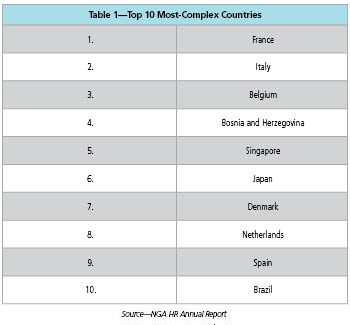Introduction: An Evolving Landscape of Payroll Requirements
 Multinational organizations are facing critical challenges in managing rapid payroll legislative changes as well as increased expansion into new geographies. This storm of operational disruption and new regulations creates an ever-evolving wave of new requirements and process adjustments. Simultaneously, the pressure to maintain accurate payroll processing, tax withholding, and statutory reporting requirements in countries throughout the world is growing.
Multinational organizations are facing critical challenges in managing rapid payroll legislative changes as well as increased expansion into new geographies. This storm of operational disruption and new regulations creates an ever-evolving wave of new requirements and process adjustments. Simultaneously, the pressure to maintain accurate payroll processing, tax withholding, and statutory reporting requirements in countries throughout the world is growing.
Recall when Brazil announced its move to eSocial, or when France transitioned to Déclaration Sociale Nominative; were you ready? Organizations whose payroll functions do not remain compliant could be at risk of incorrect payrolls and dissatisfied employees. In Part I of this article, a typical real-life scenario and some of the most complex global payroll practices are discussed.
A Scenario: How the Story Unfolds
Imagine a scenario that is becoming more common these days, in which payroll professionals are faced with compliance changes more often than in past years. You are a veteran payroll practitioner. The Chief Financial Officer and the VP of HR call a meeting to explain that an expansion is about to take place. Your involvement is needed to support payroll efforts in 10 new countries for the company’s sales and operations units. The company has never done business in these 10 countries before, and some of them have very complex labor laws and rapidly changing regulations.
This type of scenario happens all too frequently. Even if you consider your company too small (or too large) globally to focus on payroll tax compliance efficiency, your business should be ready for a tax agency audit or a findings review by the country’s social insurance agency. The by-product and perhaps of greater concern are:
- Getting up to speed with the new country regulations
- Determining how to get the payroll operations and process up and running
- Doing it in a compliant nature, both accurately and on time
How do you prepare for this type of disruption?
Your company’s bottom line and, more importantly, its brand, could be at risk if you do not maintain a compliant multinational payroll operating model. There are five keys to help organizations address challenges that arise in payroll compliance, which will be discussed in Part II of this article in the next issue.
Global Payroll Complexity Varies by Country
Merger and acquisition activities tend to highlight weaknesses in global payroll practices. For instance, what if the group your organization just acquired in Brazil still uses manual time sheets? What type of transitional preparation and training are required? How complex can Brazil’s payroll process be?
The answer to the last question is very complex. The 2017 Global Payroll Complexity Index by NGA Human Resources lists the most and least complex countries in terms of payroll (see Table 1). The complexity is based on five categories: payroll data, parameters, calculation, government reporting, and geography.
Table 1—Top 10 Most Complex Countries for Global Payroll

*Source—NGA HR Annual Report
Some of the most complex countries and associated payroll landscapes include:
- France's complex system and implementation of Déclaration Sociale Nominative (DSN)—Effective early 2017, France implemented DSN, in which all employers and payroll providers are required to go through an automated system for social contributions. DSN replaced a manual process that had been used for many years. The intention was to make it easier and safer to comply with social welfare reporting since employers had to report payroll data to dozens of agencies using separate forms. DSN should make compliance more streamlined, which is critical as France tends to have some of the steepest fees for noncompliance related to employment law.
- Italy’s complex system—Italy is renowned for its insistence on communication for every aspect of payroll to multiple agencies that do not share the data or formats to report. The payroll administrator has to be in contact with the tax department, Instituto Nazionale Previdenza Sociale, and statutory pension/health funds even if an employee just changes his or her address. Any type of contract must be reported to the government, and payroll has to deal with multiple divisions of social security. In other words, the reason Italy is so complex lies in the fact that the regulatory changes and interpretation come from multiple agencies that do not share data or a common communication platform to convey that information to companies.
- Japan’s complex system and implementation of My Number—Japan’s complex pay slip contains more than 70 categories. This ranks Japan as one of the world’s most complex payroll regions. Japan implemented a mandate that unified and streamlined government agency processes in social security, taxation, and disaster relief. The underlying goal was to prevent criminal activity through tax crimes. All HR information systems (HRIS) had to be updated for calculation and policy changes. In addition, the Japanese language is one that is not shared across other Pacific region countries, making it that much more complex when it comes to payroll service delivery in general.
- Brazil’s complex system and implementation of eSocial—Brazil’s is the world’s seventh-largest economy. Its complex payroll is due in part to ever changing laws and regulations as well as an increase in labor unions. About 922 legal changes happen every year in Brazil, with about 60% of them affecting payroll. Newly deployed system eSocial was intended to streamline payroll processing. ADP’s explanation of eSocial states that it “digitalizes the process of submitting labor and payroll events and sends all information to a single government database.”
Noncompliant Global Payroll's Consequences
There are potentially significant financial, security, and morale consequences to being noncompliant with local labor and payroll regulations. A company could be severely affected by fines and penalties resulting from a noncompliant payroll. Country-specific examples of mistakes that trigger fines and penalties include:
- Australia—Misclassifying workers as independent contractors when they qualify as employees; penalty: fine up to AUD250,000
- Brazil—Being found guilty of worker discrimination; penalty: fine of 10 times the employee’s salary
- Germany—Failure to provide an accurate hand-signed reference, or Abeitszeugnis; penalty: legal action by employee
- Hong Kong—Failure to enroll employees in Mandatory Provident Fund (MPF) scheme; penalty: HKD350,000 fine and three years’ imprisonment
- Mexico—Failure to provide skills and competency training plan for staff; penalty: fine of 5,000 times minimum salary
- Nigeria—Failure to remit employees’ pension contribution within two weeks of payroll; penalty: fine of 3% of pension contribution
Examples of noncompliance fines and penalties that have transpired for companies in the United States include:
- Family and Medical Leave Act (FMLA) notification—Not notifying employees of their leave rights could result in lawsuits with the average cost to defend totaling $78,000. This amount is just the average cost to defend, not the cost of fines and penalties that may be assessed.
- Affordable Care Act (ACA) filings—A single filing error can trigger fees up to $500 for each employee
- COBRA compliance—If noncompliant, penalties of $110 per day per beneficiary can be incurred by the company. COBRA provides continuation of group health coverage that otherwise might be terminated.
- Americans with Disabilities Act (ADA) accommodations—First-time violators’ maximum penalty is $75,000
In Part II of this article, we will finish the remaining noncompliant global payroll consequences to security and morale as well as look at the five important keys to maintaining a compliant global payroll.
 Matthew Busanic is an experienced Senior Manager within the People Advisory Practice at Ernst & Young with a concentration in global payroll, human resources, intelligent process Automation, Technology, equity processing, project management, and continuous process improvement. Busanic has more than 30 years of experience in the payroll industry. He specializes in global payroll implementations and operational efficiencies with various platforms. Busanic has led and successfully managed several multinational payroll and human capital transformation deployments, with a focus on payroll compliance, operations, and intelligent process automation. His engagements includes successful projects for Fortune 100 and Fortune 500 clients in the chemical, consumer products, entertainment, financial services, hospitality, information technology, manufacturing, pharmaceutical, and retail industries.
Matthew Busanic is an experienced Senior Manager within the People Advisory Practice at Ernst & Young with a concentration in global payroll, human resources, intelligent process Automation, Technology, equity processing, project management, and continuous process improvement. Busanic has more than 30 years of experience in the payroll industry. He specializes in global payroll implementations and operational efficiencies with various platforms. Busanic has led and successfully managed several multinational payroll and human capital transformation deployments, with a focus on payroll compliance, operations, and intelligent process automation. His engagements includes successful projects for Fortune 100 and Fortune 500 clients in the chemical, consumer products, entertainment, financial services, hospitality, information technology, manufacturing, pharmaceutical, and retail industries.